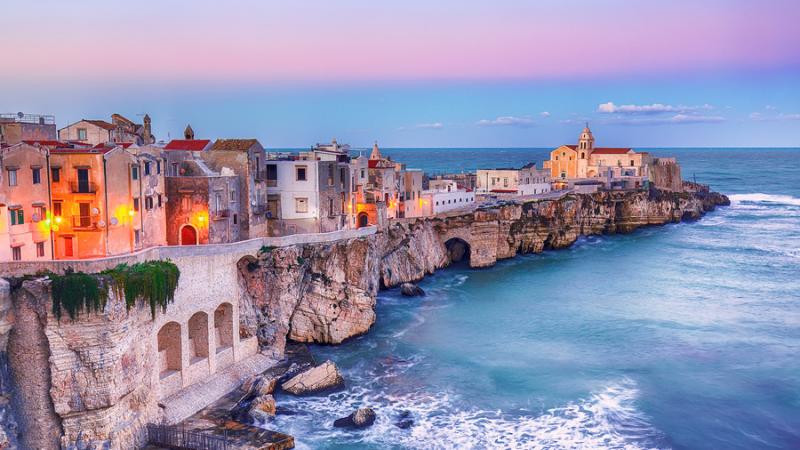Vieste, A Perfect Summer Destination
ITA:

Perched on a cliff on the Gargano promontory of Puglia, Vieste is a great summer destination. The town has been awarded the Blue Flag by the Foundation for Environmental Education several times thanks to the quality of its waters, part of the Gargano National Park.
Vieste's most known site is Pizzomunno, a vertical rocky monolith standing at 25 m (82 ft) near Spiaggia del Castello. The harbor is where you go for water sports, while the surrounding Parco Nazionale del Gargano is ideal for cycling and hiking lovers.
Vieste is also the starting point for excursions to the Tremiti Islands, off the coast.
The old town is fascinating, with its narrow alleys, Romanesque Cathedral and the Castle, a massive building built by the Swabians, which overlooks the town with its imposing profile.
Along the coast are the trabocchi, ancient fishing machines on piles that in Puglia are only found in this area as they are more common along the coasts of southern Abruzzo and Molise.
As for the cuisine, choose among: stuffed eggplants and peppers, dried tomatoes in oil , orecchiette with turnip tops, taralli with fennel, fish soup (‘o ciambott), caciocavallo, cacioricotta and scamorza cheeses, extra virgin olive oil, and the dessert k'lustr, fried cakes covered with honey and almonds.
Arroccato su una scogliera sul promontorio del Gargano in Puglia, Vieste è una fantastica destinazione estiva. La città è stata premiata più volte con la Bandiera Blu grazie alla qualità delle sue acque, parte del Parco Nazionale del Gargano.
Il luogo più conosciuto di Vieste è Pizzomunno, un monolite in pietra calcarea bianca alto circa 25 metri, all’inizio della Spiaggia del Castello. Il porto è il luogo ideale per gli sport acquatici, mentre il circostante Parco Nazionale del Gargano è l'ideale per gli amanti del ciclismo e dell'escursionismo.
Vieste è anche il punto di partenza per escursioni alle Isole Tremiti, al largo della costa.
Il centro storico è affascinante, con i suoi stretti vicoli, la cattedrale romanica e il castello, un imponente edificio costruito dagli Svevi, che domina la città con il suo imponente profilo.
Lungo la costa i trovano i trabocchi, antiche macchine da pesca che in Puglia si trovano solo in questa zona in quanto sono generalmente più diffuse lungo le coste dell’Abruzzo meridionale e del Molise.
Per quanto riguarda la cucina, puoi scegliere tra: melanzane e peperoni ripieni, pomodori secchi in olio, orecchiette con cime di rapa, taralli con finocchio, zuppa di pesce ('o ciambott), caciocavallo, cacioricotta e scamorza, olio extra vergine d'oliva, e k'lustr, dolce fritto ricoperto di miele e mandorle.











